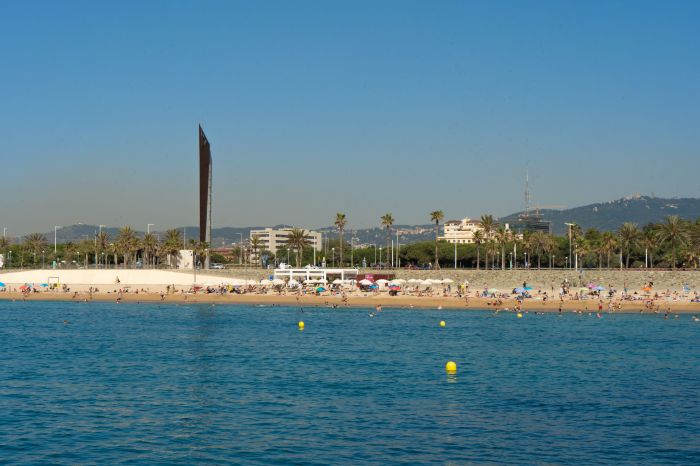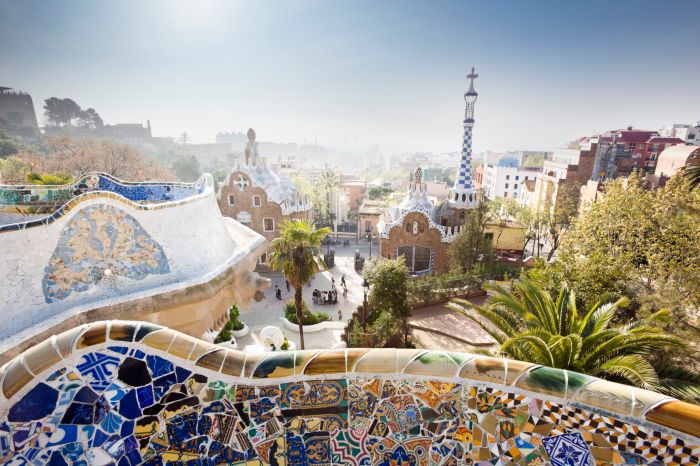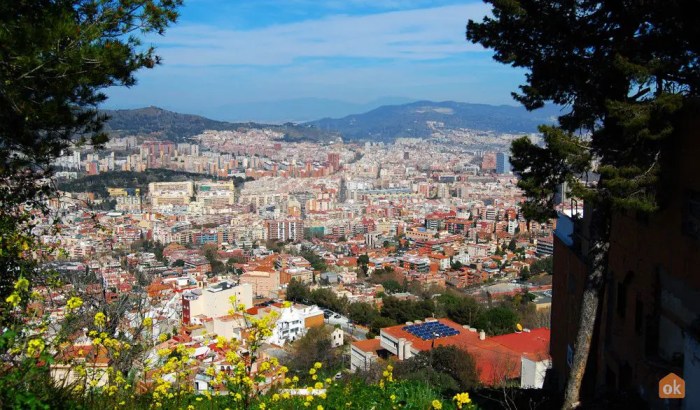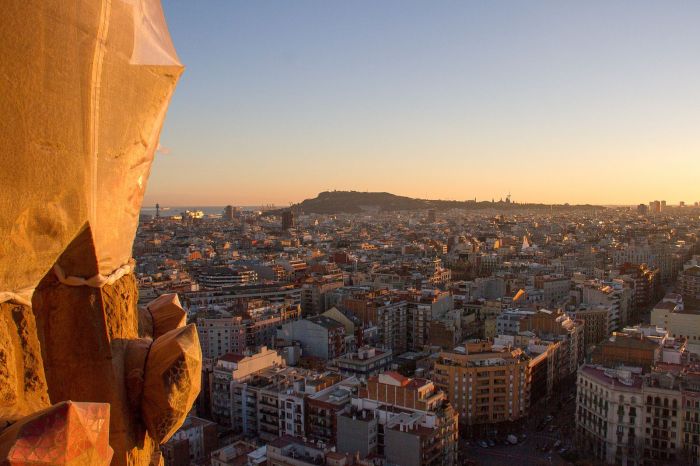Barcelona weather – Barcelona’s weather, a symphony of sunshine and gentle breezes, paints a vibrant canvas that enhances the city’s allure. From the warmth of summer to the crisp air of winter, the weather here plays a harmonious role in shaping the rhythm of life.
As the gateway to the Mediterranean, Barcelona’s location on the Iberian Peninsula grants it a unique climate that blends continental and maritime influences, creating a delightful year-round experience.
Overview of Barcelona Weather

Barcelona, a vibrant city nestled on the northeastern coast of Spain, enjoys a Mediterranean climate characterized by warm, dry summers and mild, wet winters. Its strategic location on the shores of the Mediterranean Sea and proximity to the Pyrenees mountains significantly influence its weather patterns.
Barcelona’s proximity to the Mediterranean Sea acts as a natural temperature regulator, moderating both summer and winter temperatures. The warm waters of the Mediterranean absorb heat during the summer months, releasing it gradually during the cooler months, resulting in a more temperate climate. Additionally, the Pyrenees mountains to the north provide a barrier against cold northern winds, further contributing to Barcelona’s mild winters.
Seasonal Weather Variations

Barcelona’s Mediterranean climate features distinct weather patterns across the seasons, offering a diverse range of experiences throughout the year.
The following table provides a comprehensive overview of the seasonal weather variations in Barcelona, including temperature ranges, precipitation levels, and humidity:
Temperature Ranges
| Season | Average High (°C) | Average Low (°C) |
|---|---|---|
| Spring (March-May) | 15-25 | 10-15 |
| Summer (June-August) | 25-35 | 18-25 |
| Autumn (September-November) | 15-25 | 10-15 |
| Winter (December-February) | 10-15 | 5-10 |
Precipitation Levels
| Season | Average Monthly Precipitation (mm) |
|---|---|
| Spring (March-May) | 40-60 |
| Summer (June-August) | 10-20 |
| Autumn (September-November) | 60-80 |
| Winter (December-February) | 40-60 |
Humidity
| Season | Average Relative Humidity (%) |
|---|---|
| Spring (March-May) | 60-70 |
| Summer (June-August) | 50-60 |
| Autumn (September-November) | 60-70 |
| Winter (December-February) | 70-80 |
Temperature and Humidity: Barcelona Weather

Barcelona enjoys a Mediterranean climate, characterized by warm, dry summers and mild, wet winters. The average temperature throughout the year is a comfortable 15.6°C (60°F), while the average humidity level is 70%.
The warmest months are July and August, with average temperatures reaching a pleasant 26°C (79°F). The coolest months are January and February, with average temperatures dropping to a chilly 9°C (48°F).
Barcelona’s weather is typically mild and sunny, with warm temperatures year-round. However, if you’re looking for a change of pace, consider visiting Albany , New York. Albany has a more temperate climate, with hot summers and cold winters. But no matter where you go, be sure to check the weather forecast before you travel so you can pack accordingly.
Humidity
Barcelona’s humidity levels are relatively high throughout the year, averaging around 70%. However, the humidity levels can vary significantly depending on the season. During the summer months, the humidity levels tend to be lower, while they tend to be higher during the winter months.
The beautiful weather in Barcelona is perfect for exploring the city’s many attractions, including the accademia gallery , which houses masterpieces such as Michelangelo’s David. After admiring the artwork, take a stroll through the nearby Boboli Gardens or enjoy a meal at one of the many restaurants in the area.
The weather in Barcelona is typically mild year-round, making it a great destination for any time of year.
Temperature Extremes
While Barcelona’s climate is generally mild, there can be occasional extreme temperatures. The highest temperature ever recorded in Barcelona was 38.2°C (100.8°F) in July 1982, while the lowest temperature ever recorded was -10.0°C (14°F) in February 1956.
Precipitation Patterns

Barcelona experiences a Mediterranean climate characterized by mild, wet winters and warm, dry summers. Precipitation is relatively infrequent, with an average of 635 mm (25 inches) of rainfall annually. However, the distribution of rainfall throughout the year is uneven, with most precipitation occurring during the fall and winter months.
Monthly Precipitation Levels
The following chart illustrates the monthly precipitation levels in Barcelona:
| Month | Average Precipitation (mm) |
|---|---|
| January | 58 |
| February | 43 |
| March | 41 |
| April | 48 |
| May | 53 |
| June | 28 |
| July | 18 |
| August | 23 |
| September | 51 |
| October | 90 |
| November | 94 |
| December | 66 |
As you can see from the chart, precipitation is highest during the fall and winter months, with October and November being the wettest months. During these months, it is not uncommon for Barcelona to experience heavy rainfall and occasional thunderstorms.
Barcelona’s weather is known for its pleasant temperatures and ample sunshine, making it a popular destination for tourists year-round. However, if you’re looking for a tropical getaway, consider aguadilla puerto rico , which boasts warm waters, pristine beaches, and lush rainforests.
Despite the differences in climate, both Barcelona and Aguadilla offer unique experiences for travelers seeking sun, culture, and adventure. Barcelona’s vibrant city life and historical landmarks complement Aguadilla’s tranquil beaches and outdoor activities, making them ideal destinations for a diverse and memorable vacation.
In contrast, the summer months are generally dry, with July and August receiving the least amount of rainfall. During this time, it is rare to experience more than a few days of light rain.
Wind and Sunshine
Barcelona’s weather is heavily influenced by its location on the Mediterranean coast and its proximity to the Pyrenees mountains. The city experiences a variety of wind patterns, which can have a significant impact on the overall weather conditions.
The prevailing wind direction in Barcelona is from the northeast, known as the Tramuntana wind. This wind is typically cool and dry, and it helps to keep temperatures in Barcelona relatively mild throughout the year. However, when the Tramuntana wind is particularly strong, it can cause choppy seas and make it difficult to enjoy the beaches.
Sunshine Hours
Barcelona enjoys an average of 2,524 sunshine hours per year, making it one of the sunniest cities in Europe. The number of sunshine hours varies throughout the year, with the most sunshine occurring during the summer months. In July and August, Barcelona averages over 10 hours of sunshine per day.
Extreme Weather Events

Barcelona experiences a Mediterranean climate, characterized by mild, wet winters and warm, dry summers. Extreme weather events are relatively rare, but they can occur.
Heatwaves
Heatwaves are characterized by prolonged periods of unusually high temperatures. They can be dangerous, especially for vulnerable populations such as the elderly, young children, and those with chronic health conditions. Barcelona has experienced several heatwaves in recent years, including one in 2019 that saw temperatures reach 40 degrees Celsius (104 degrees Fahrenheit).
Storms, Barcelona weather
Storms are another type of extreme weather event that can occur in Barcelona. These storms can be accompanied by heavy rain, lightning, and hail. In some cases, storms can also produce tornadoes. In 2021, a storm in Barcelona caused widespread flooding and damage to buildings.
Droughts
Droughts are periods of unusually low rainfall. They can have a significant impact on agriculture, water supplies, and the environment. Barcelona has experienced several droughts in recent years, including one in 2018 that lasted for several months.
Weather Forecasting

Weather forecasts in Barcelona are generally accurate and reliable, especially for short-term predictions. The city’s proximity to the Mediterranean Sea and its location in a temperate climate zone contribute to its predictable weather patterns.
Weather prediction in Barcelona is primarily based on numerical weather prediction (NWP) models. These models use mathematical equations to simulate the behavior of the atmosphere and predict future weather conditions. The models are initialized with data from weather stations, satellites, and other sources, and then run on supercomputers to generate forecasts.
Limitations of Weather Prediction
While weather forecasts in Barcelona are generally reliable, there are limitations to their accuracy and predictability. These limitations include:
- The chaotic nature of the atmosphere: The atmosphere is a complex and chaotic system, and small changes in initial conditions can lead to large differences in the forecast.
- The limited availability of data: Weather models rely on data from weather stations, satellites, and other sources, but there are always gaps in the data. This can lead to errors in the forecast.
- The limitations of the models themselves: Weather models are mathematical simplifications of the real atmosphere, and they cannot perfectly capture all of the complexities of the system.
Impact on Tourism and Daily Life

Barcelona’s pleasant weather conditions significantly impact tourism and daily life in the city. The city’s mild winters and warm summers attract a large number of tourists throughout the year, making tourism a vital part of Barcelona’s economy. Outdoor activities such as walking, cycling, and swimming are popular among both tourists and locals. The weather also influences transportation and infrastructure, with public transportation and outdoor infrastructure designed to accommodate the city’s weather patterns.
Impact on Tourism
Barcelona’s favorable weather conditions make it an attractive destination for tourists year-round. The city’s mild winters, with average temperatures hovering around 10°C (50°F), allow tourists to explore the city’s many outdoor attractions comfortably. The warm summers, with average temperatures reaching 28°C (82°F), are ideal for swimming, sunbathing, and enjoying the city’s vibrant outdoor culture. The city’s long sunshine hours, averaging over 2,500 per year, further enhance its appeal as a tourist destination.
Final Conclusion

In Barcelona, the weather is more than just a backdrop; it’s an integral part of the city’s identity. Whether you’re basking in the summer sun along the beaches or seeking solace in the cozy cafes during winter, Barcelona’s weather offers a captivating tapestry of experiences that will leave you enchanted.
Frequently Asked Questions
What is the best time to visit Barcelona?
Spring (April-May) and autumn (September-October) offer pleasant temperatures and fewer crowds.
How much rain does Barcelona get?
Barcelona receives an average of 600 mm of rainfall annually, mostly concentrated in spring and autumn.
Is Barcelona a windy city?
Yes, Barcelona experiences moderate winds, particularly during winter and spring, due to its coastal location.